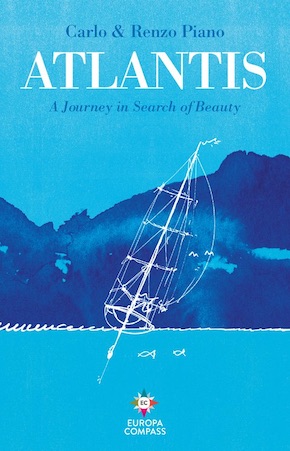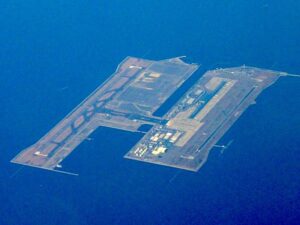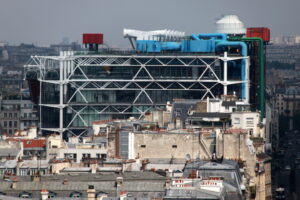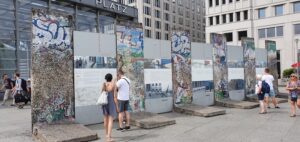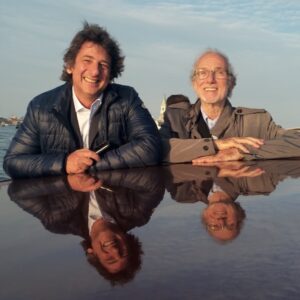Travels around one’s father
by Mika Provata-CarloneCarlo and Renzo Piano’s Atlantis: A Journey in Search of Beauty is an audaciously ambitious, unfailingly beguiling book. It is intimate and deliberately public all at once, vigorously peripatetic and languidly philosophical, a complex offspring of the tradition of ancient travelogues of ignorance and knowledge after the model of Herodotus, Pausanias, Ptolemy, Scylax and Hanno, Strabo, Dionysius Periegetes, Polybius or Euhemerus. It is even a territorial statement, after the etymology of the word geography: it is a bold rewriting of the mappa mundi, a new world-narrative of sorts, and the story of a new world. There are hints of a catabasis, of Orpheus descending into the underworld, and of Phaethon-like ascents into the heavens. There is the sea, or a great many seas, each distinct, yet archetypally connected, each time the symbol of loss, retrieval, nostos and the pain of desire, the yearning for a place of belonging, and for the space of transcendence: “the sea is the dwelling place of what we have lost, what we had wished for, our broken dreams, grief and spilt tears.” There is a defiant claim for a new caput mundi in Genoa. And a determined quest, a fearless journey, in search of an elusive yet irresistible utopia of beauty and meaningfulness – embodied, we are told, by the mythically real Atlantis.
Underlying the book throughout are countless echoes, images, legends; history and stories, personal references, solid or dreamt-of buildings. Foremost among these Beatrice-like allusions guiding the authors and us on this physical and existential periplous, are clear hints to the first lines of Homer’s Odyssey, which Carlo Piano claims as his own signifier, and Renzo as his true reflection in the world. You could easily miss them, but they are there, on the back cover, introducing and defining categorically the authors and the task at hand: Carlo Piano is the curious explorer of the cities of many people, Renzo Piano is the builder of cities, the one who understands the minds and customs of those who live in them. The old-fashioned trope of first introducing oneself before striking what is certain to become an intense intellectual conversation, is here placed centre stage. This father-and-son dialogue or parallel process of being and becoming (another Odyssean trope, if ever there was one) promises to be an intoxicatingly rich one, and Atlantis fulfils that promise with deeply engaging immediacy, with stark (sometimes unforgiving) honesty, and with siren-song lyrical allure.
Renzo is man the measure, the master builder, the Father, Architect, Surveyor, Explorer. He is both the maker and the essence of words and of the cosmos, even if poetry belongs to Carlo.”
Carlo seeks to be the poet of the unknown; the bard of the mythical narratives of the everyday. He is the storyteller, the one who sets the stage, animates the characters, yet he does not claim to create. He is only there to chronicle and attest, to analyse post factum and for posterity. Renzo is man the measure, the master builder, the Father, Architect, Surveyor, Explorer. He is both the maker and the essence of words and of the cosmos, even if poetry belongs to Carlo. Carlo’s poetry is redolent, indulgent, intertextual, cross-cultural; Renzo’s words and his cosmos are succinct, perfectly poised, mathematically precise, transgressive and transcendent at the same time, like his buildings. Their discourses, perspectives, tonalities and harmonies are vastly different; yet at heart they are both the same: Genoese. The Genoese landscape, dialect, history, music, food, winds, wave patterns and seamanship, the orgolio of the land and its people, are central to Atlantis, to the very quest for Atlantis. Equally vital is a life through art and craftmanship – the art and craft of the writer and of the architect, the verbal or urban structures that define them and sustain them.
The search for Atlantis is both real and a pretext of sorts. For Renzo, it is a quest for the ideal city and building, for the meaning of habitus and of the relationship between edifice and monument, construction and creation, the past and the present; he is looking doggedly for the singular space that can contain the eternal and the universal, as well as man’s transient presence. For Carlo it is a search for the ideal expression of meaning, for a distillation of the value of existence, for the polyphony arising from the words and voices that have echoed across time; it is also a search for his father’s mind, soul and legacy, the trace of his private and public presence. Their Atlantis in this sense is a protean topos – it is Odysseus’ small, ordinary and tangible Ithaca, as well as a timeless otherworldly Utopia; it is a gesture of solidly physical embodiment but also of sublimation. Ultimately, it is a search for the materiality of perfection, for the dialectics between tectonic and a-tectonic form, for an earthly poetics and practice of transfiguration and transcendence: “It was in his studio [in Genoa’s Punta Nave], suspended between earth, water, and sky, when I first heard my father utter the name Atlantis.”
Renzo Piano is invited to join a cartographic expedition aimed at updating the Italian Navy’s sea charts; it is an opportunity to travel, to “drink life to the lees”, “to strive, to seek, to find and not to yield.” The search for Atlantis, ostensibly a fancy and a whim on Renzo’s part, to be indulged by Carlo, entails undertaking a different, double cartographic project: it will involve charting the relationship between father and son, tracing the balance between the highly conspicuous architect and the fiercely private man, as well as the drawing up of a new global map of the urban oecumene, whose foremost landmarks are Renzo’s most iconic buildings. The official route of the expedition thus becomes a journey into memory and a record of commemoration. It is an invariably fascinating itinerary, an intimate conversation between an ageing Odysseus and a not so young Telemachus, a public manifesto of architectural principles and ideals, philosophies of art and of aesthetics, the ethics of community building and the politics of modernity, as well as a private testament to the power behind words and buildings.
For Renzo, the answers require form and method. The encounter with each of his buildings becomes a distillation of a credo of practice and way of life, full of startling insights and thrilling contradictions.”
Casual references lead to vast tales and forays into human history, to long meditations on the cost and value of our process of humanisation, to unmistakable literary echoes – you will run into many of the afterlives of Homer’s hero at some point or other in the story, from Virgil, Dante and du Bellay, to Tennyson, Verne, Cavafy or Borges, though perhaps not Joyce… Atlantis is full of questions regarding existence, mortality, eschatology, reason, conscience and intuition, materiality and spirituality. It is a treatise on man’s relationship to the natural environment, on the substance and essence of civilisation, on the meaning of progress and regression. For Renzo Piano, the answers require form and method, an exponential process of being and becoming through reason and contemplation. The encounter with each of his buildings becomes a distillation of a credo of practice and way of life, full of startling insights and thrilling contradictions. There is unquestionable self-certainty, but also a certain innocence, the innocence of a noble savage or the yet unformed pure consciousness of a child: “Everything in my father’s memory is magnified by the imagination of a child… Sensations have settled like dust inside the Explorer, one layer deposited on top of another.”
Both father and son have a particular sensibility for beauty, for a grounded lightness, in a constant dialectics with what destabilises it or adulterates it. The aim of architecture, of sounds and of words is to defy gravity, noise, meaninglessness; a sense of rootedness, of origins, is what leads to originality, just as a yearning for beauty leads to creation. “Nostalgia [on the other hand] is dangerous, it can be permanently disabling. Nostos is another thing; the Greek word means returning home, not pining for the past. It is the sensation and recognition of your roots,” writes Renzo. His ‘lightness’ as an architect relies on his steadfast solidity as a civil engineer, as evinced in his acheiropoieton island for his airport in Osaka Bay. The structure’s near-immateriality gives it anti-seismic flexibility, and therefore indestructibility, just as dialectical thinking allows the mind to explore, engage, evolve. Modularity and localisation are key themes in Renzo Piano’s way of conceiving and of building what might even seem impossible.
His theory is that one does not have to start with perfection, but with a creative perspective as regards ‘fragments’, a term he borrows from Italo Calvino. “By making… local interventions… you set in motion a virtuous circle of regeneration.” He has been guided from the beginning by a “hidden compass” that points the way and prevents one from missing the almost Dantean “right path”. “Whether we listen to our hidden compass or not, is another matter.” Both this question of listening and the ethical responsibility involved in any act or degree of local intervention are deeply personal. As he writes, he is well “familiar with being tugged between preserving the memory of a place and needing to reinvent, with keeping a record of the past, and uncovering something new.”
The personal experiencing of the events of September 11, 2001 is particularly haunting, as is the discussion on the further repercussions that the terrorist attack would have for architecture, for urban landscapes.”
Interwoven with the personal reflections, architectural impressions and musings, and the broader philosophical poetics, are crisp and poignant ethno-sociological observations or even mordant criticisms. Nothing is too great or too little: the politics and policies of Ellis Island and US immigration history may be pitted against the ambiguous social mores of the Winchester Geese, the Southwark prostitutes who were licensed to practise their trade by the Archbishop of Winchester; the typologies of Japanese society may be paired with the fact that New York’s Broadway “retraces the route of an old Native American path”, or with Carlo’s exploits in nursery school. The personal experiencing of the events of September 11, 2001 is particularly haunting, as is the discussion on the further repercussions that the terrorist attack on the Twin Towers would have for architecture, for urban landscapes, and also for Renzo Piano’s own philosophy of aesthetics. His tower for The New York Times Building reflects the new problematisations, the old necessities, the unchanging critical bond between human community and social space: “The barbarity of terrorism attacks a city because, whatever its flaws, a city represents the values of civilisation.” Reflections on barbarity and civilisation create organic parallelisms with the purpose of museums and the psychosynthesis of collectors, with the architect’s discussions with Umberto Eco on the near-existential role of places of reading and contemplation, as he designs the extension to the Morgan Library: “a museum rescues works of art from the wear of time. It is also a factory that generates curiosity and critical awareness… A fortress [against] barbarian invasions whether from near or far.” The emphasis on cultural standards, on civilisational criteria, on a certain duty to every layer and side of history, on barbarity as a clear and unambiguous category, is stressed with a particularly strong accent: “Just as we cannot reset the clock by destroying the past, we cannot rip the pages from a history book only because we wish it were different.” The architect of industrial postmodernist minimalism certainly does not believe here in a tabula rasa of culture or of memory…
Whether or not one shares the same vision of aesthetics and beauty with Renzo Piano (and one gets the distinct impression from Carlo’s comments that the apple may have fallen a little further from the tree in their case), one cannot but relish the journey of ideas, the intellectual, even ethical search that underlies each of Piano’s designs. The famous Pompidou Centre in Paris (known to locals as Beaubourg) is a case in point. Neighbouring Les Halles (roughly the equivalent of Spitalfields in London, or New York’s Meatpacking District), it aimed to challenge tradition and to break new social ground by shifting the centre of cultural gravity. It was as much a daring feat of avant-garde design, as a centuries-old practice of cross-pollination. Richard Rogers and Renzo Piano won fame (or for some infamy) overnight with their uncompromisingly nuts-and-bolts (or pipes-and-glass) new building. Is it beautiful? Renzo Piano makes a staunch and elegiac case, rallying Italo Calvino’s story ‘Armilla’, from Invisible Cities, to his cause. Those who have tried (and perhaps failed) to work in its iconoclastically classic library, or those who live in the unevenly redeveloped Les Halles area, may not find themselves so easily convinced. Yet the theory (in the Greek sense of vision) behind the praxis remains fascinating, as are the dialectics that it invariably, and so persistently, engenders.
Readers may hear echoes of W.G. Sebald’s assessment that post-WWII Germany opted for erasure in order to build a new German miracle on a ‘clean slate’ of oblivion.”
The existential analytic (to borrow the term from John Took) of Berlin as a locus of memory and as the site of specific moments in history is, on the other hand, unsettlingly ambiguous, filled with a certain Italian malaise as regards WWII, its antecedents and its aftermath. The emphasis is now placed on the destruction caused by the Allied bombings, with a noted silence as to its contextualising causes, or its proffered necessity. The Cold War dominates with chilling ‘neutrality’, as though history before it were simply never there. “A few blackened walls, shaggy trees, no tangible sign of the past. An historic centre with no footprint, a memorial site with no memorial… After they tore down the Wall, not a single brick was left to commemorate what happened. They wanted to forget. They eliminated it completely, as if it had never existed.” Readers may experience a sense of tragic irony in these words, as well as hear echoes of W.G. Sebald’s assessment that post-WWII Germany opted for erasure in order to build a new German miracle on a ‘clean slate’ of oblivion, rather than engage with a particularly difficult remembrance… Another hermeneutical tour de force is the revisionist definition of the term Mare Nostrum. It does not indicate, we are to believe, Roman territorial claims and its dominion over the Mediterranean Sea, but rather the sheer benevolence and disinterestedness of the Pax Romana: thanks to the Romans, “the Mediterranean was transformed into a peaceful lake bustling with life, with traffic and travellers…”
The central puzzle, however, is Atlantis itself, its place as an ideal state, topos and vision, or even as an object of desire. Renzo Piano tells us that, once again, he went back to the origins for the story, to Plato’s Timaeus and the fragmentary Critias, yet the way fragments of the myth are here chosen to supersede the whole might raise a few classicist eyebrows. Critias’ story of Atlantis is a political paradigm and a riddle, offered under the guise of a repayment for Socrates’ ‘philosophical entertainment’ of the night before, which was no less than the Republic, arguably the fullest Platonic treatise on the ideal state. In this myth, supposedly as told to Critias’ great-grandfather by Solon, who had it from an Egyptian priest, who himself read it in the archives of an Egyptian temple, ancient Athens is the ideal polis, the perfect state. Atlantis, the Island of Atlas, was initially blessed, magnificent and prosperous, yet it later fell into moral decline as a result of the intermixing of gods with mortals – through the disregard of human limitations and divine perspectives. It conquered what was considered then the entire world driven by greed and overweening pride, a covert reference to Persia, but also (and rather daringly) to the Athens of Plato’s time. It became hubristic, unworthy of its divine paideia and cultural potential, a totalitarian and colonialist power. It is a Goliath of political philosophy. Ancient Athens, David-like, is in the end the only city to stand against Atlantis and defeat it, setting the rest of the world free. Perhaps rather perplexingly, both cities perish in the conclusion to the story, within the span of a single day and night, from an earthquake and a deluge, a clear act of divine punishment against hubris. Plato singles out the story of Atlantis as a “made-up story”, an explicit narrative construct that allows him to deliberate on actual political concerns. For Plato, Atlantis is far from ideal, it is an apotropaic paradigm, a terrible dystopia, and a stark reminder to his contemporary Athens that it may have lost its way.
Perhaps there is a twinkle in Carlo Piano’s eye as we turn the final page? Is Architecture rather than Genoa the true ideal realm of existence?”
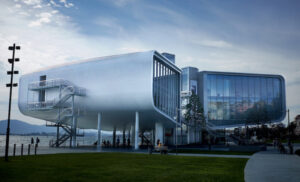
Renzo Piano’s Centro Botín, Santander. Angel de los Rios/Wikimedia Commons
The Nachleben of the Atlantis myth is itself the stuff of legend. Its popular-culture reputation as an exotic, long-lost underwater Arcadia is largely due to Francis Bacon’s New Atlantis and Thomas Moore’s Utopia, as well as, more chillingly, to Madame Blavatsky, who would use the myth in her Secret Doctrine to promote a theory of racial rather than Darwinian evolution. The Nazis would further bend and flex this new version of the story to suit their purpose, casting Thule as their own Atlantis, and picking and choosing between Hyperborean supermen and invincible Mongolian warlords to make Madame Blavatsky’s racial profiling fit their bill. Written in 1941, W.H. Auden’s own poem ‘Atlantis’ may have picked up on the irony inherent in the various mutations of Plato’s original parable: “Being set on the idea / Of getting to Atlantis / You have discovered of course / Only the Ship of Fools is / Making the voyage this year”.
More to the point, in the Timaeus the story of Atlantis is followed by an account of the genesis of the world, intended to complement the Republic of the previous night. It is a discourse on the constant ‘becoming’ of the universe, on the inadequacy of the natural sciences (the science of physis) to provide a true model. Only metaphysics and mathematics can offer certainty, truth and finality. In this creation story, the world is the design of a divine Craftsman, Artisan, Demiurge, Creator, Maker, who brings order out of chaos, form out of amorphous substance, by intuiting and emulating the immutable and timeless pattern behind all things. The resulting universe is the cosmos, a word that in Greek shares the same etymology as order, structure and adornment, and by extension beauty. The references throughout Atlantis to architects as the prime movers and creators are not that distanced from Plato’s demiurge, even if one might contest the divinity of the former; the exploration of the role of science, of techne, in the creation of sustainable human communities, and the emphasis on beauty, order, the theme of measurement (mathematics), and on a more or less existential philosophy, all inevitably beg the question as to why Atlantis as the ideal urban kosmos? After all, for Plato, the choice of the ideal life is made by Odysseus – it is, pace Tennyson and to an extent Cavafy, the choice of the simple life and of Ithaca. Temptingly, Atlantis ends with just that very question: will Ithaca (in the Pianos’ case Genoa) suffice? Renzo Piano gives a resounding “no” as his answer, yet the 268 pages of the book, the reflected topicality of everything he has built, conceivably belie this assertion. Perhaps there is a twinkle in Carlo Piano’s eye as we turn the final page? Is Architecture rather than Genoa the true ideal realm of existence? It is for the reader to find out, with a hint from a few more couplets from Auden’s poem: “Unless you are capable / Of forgetting completely / About Atlantis, you will / Never finish your journey.”
Carlo Piano, born in 1965, is a journalist, a curious explorer of cities and their customs, and the author of books on urban hinterlands. He shares his father’s passion for the sea.
Renzo Piano was born in Genoa in 1937 into a family of builders. Having previously partnered with architect Richard Rogers and engineer Peter Rice, he established the Renzo Piano Building Workshop in 1981, which now has offices in Paris, Genoa and New York. In 2004 he founded the Renzo Piano Foundation, a non-profit organisation dedicated to the promotion of the architectural profession through educational programmes and educational activities. Atlantis, translated by Will Schutt, is published in hardback and eBook by Europa Editions.
Read more
rpbw.com
fondazionerenzopiano.org
@EuropaEdUK
@EuropaEditions
Will Schutt is a writing tutor, literary consultant and translator, and the author of the poetry collection Westerly (Yale University Press, 2013). His recent translations include My Life, I Lapped It Up: Selected Poems of Edoardo Sanguineti (Oberlin College Press, 2018), Fabio Genovesi’s The Breaking of a Wave (Europa Editions, 2017) and Andrea Marcolongo’s The Ingenious Language (Europa Editions, 2019). He lives in Baltimore.
wcschutt.com
Mika Provata-Carlone is an independent scholar, translator, editor and illustrator, and a contributing editor to Bookanista. She has a doctorate from Princeton University and lives and works in London.
bookanista.com/author/mika/

